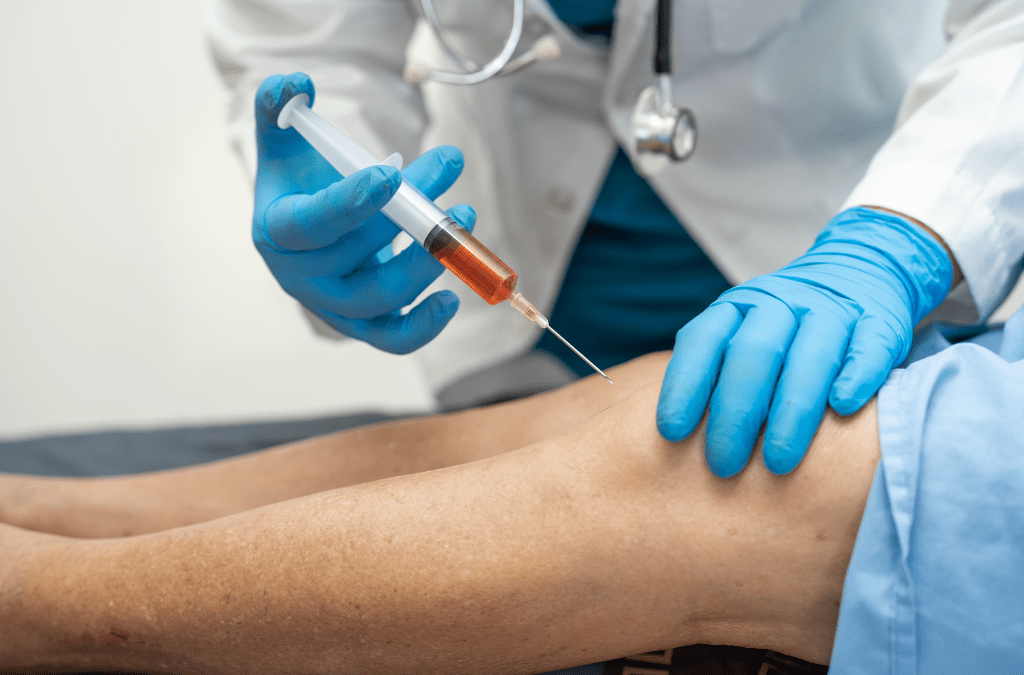Knee pain can be debilitating, especially if it stems from long-term conditions like osteoarthritis or a serious injury. If you’ve been searching for a natural, non-surgical solution, PRP knee injection might be exactly what you need. Platelet Rich Plasma therapy uses your own blood’s healing properties to promote tissue regeneration and reduce inflammation. As more people seek alternatives to surgery, PRP for osteoarthritis has become an increasingly popular choice. This minimally invasive treatment could help you get back to your active life without the downtime associated with more aggressive options.
What is Platelet-Rich Plasma Therapy?
PRP knee injection is a cutting-edge treatment that harnesses the body’s natural healing abilities to treat joint pain and injuries. PRP, or Platelet Rich Plasma therapy, involves drawing a small amount of blood from the patient and processing it to concentrate the platelets, which are rich in growth factors. These growth factors are then injected directly into the affected area of the knee to stimulate healing and reduce inflammation.
Here’s a quick look at how PRP therapy works:
- Blood is drawn from the patient, similar to a routine blood test.
- Platelets are separated from the other blood components using a centrifuge.
- Concentrated platelets are re-injected into the knee joint, where they promote tissue repair.
PRP for osteoarthritis and other knee conditions works by accelerating the body’s natural healing process, which can be slower in damaged or aging tissue. What makes PRP knee injection unique is that it uses the patient’s own cells, meaning there’s no risk of rejection or allergic reaction. It’s a minimally invasive option that can potentially provide long-term relief without the need for surgery or extensive recovery time.
Conditions PRP Knee Injections Treat
PRP knee injection has gained popularity for its effectiveness in treating various knee conditions. Whether you’re dealing with a sports injury or age-related joint issues, Platelet Rich Plasma therapy offers a natural way to promote healing. It’s particularly beneficial for those suffering from chronic conditions like osteoarthritis, where the cartilage in the knee joint has worn down over time. PRP for osteoarthritis helps reduce pain and inflammation while encouraging tissue regeneration.
Here are some common knee conditions that PRP therapy can treat:
- Osteoarthritis: PRP helps reduce joint inflammation and regenerate cartilage.
- Ligament injuries: Accelerates healing in sprains or tears.
- Meniscus tears: Assists in repairing this common knee injury.
- Tendon injuries: Promotes faster healing of tendons in the knee joint.
PRP knee injection is an excellent alternative for patients who want to avoid surgery or long-term medication use. It’s also a great option for athletes or active individuals who need a treatment that allows them to recover faster and get back to their regular activities. The minimally invasive nature of PRP means patients can benefit from faster recovery times with minimal side effects, making it an appealing option for knee pain sufferers.
Benefits of Platelet-Rich Plasma Knee Injections
PRP knee injection offers several benefits for individuals dealing with chronic knee pain or injury. One of the biggest advantages is its ability to reduce knee pain naturally, without the need for medications or invasive procedures. PRP knee injection helps promote the body’s own healing response, speeding up recovery from conditions like osteoarthritis and ligament tears.
Here are some key benefits of PRP knee injection:
Non-surgical: Avoids the risks associated with surgery.
Natural healing: Uses the patient’s own blood to accelerate tissue regeneration.
Minimal downtime: Most patients can resume normal activities soon after the procedure.
Long-term relief: Results from PRP therapy can last for months or even years, reducing the need for ongoing treatments.
PRP for osteoarthritis, in particular, can lead to improved joint mobility and function over time, making it an attractive option for individuals looking to regain an active lifestyle. Because the treatment is minimally invasive, it’s also ideal for those who want to avoid a lengthy recovery period associated with surgeries or more aggressive procedures.
What to Expect from the Procedure
When considering a PRP knee injection, knowing what to expect from the procedure is crucial for managing expectations and ensuring a smooth experience. PRP therapy is minimally invasive, which means patients can expect a relatively quick and straightforward process.
Here’s what happens during a typical PRP knee injection:
- Initial consultation: Your doctor will evaluate your condition and determine if PRP is the right treatment for you.
- Injection: The prepared PRP is injected directly into the knee joint under ultrasound guidance for precise placement.
- Post-injection care: You may experience mild soreness or swelling at the injection site, which typically resolves within a few days.
Most patients can return to their regular activities shortly after the procedure. While PRP knee injection is minimally invasive, it’s still important to follow your doctor’s post-treatment instructions to ensure optimal healing. PRP for osteoarthritis and other knee conditions offers long-term relief with minimal downtime, making it a popular option for those looking for natural, effective solutions to knee pain.
Avid Sports Medicine: Your Path to Pain-Free Knees
PRP knee injection is an innovative, natural treatment option that can help patients in San Francisco, the Bay Area, and beyond find lasting relief from chronic knee pain. Whether you’re dealing with osteoarthritis, a ligament injury, or another condition, Platelet Rich Plasma therapy offers a minimally invasive solution with long-term benefits. If you’re ready to explore how PRP knee injection can restore your mobility and ease your pain, book an appointment with Avid Sports Medicine today by visiting Avid Sports Medicine.

